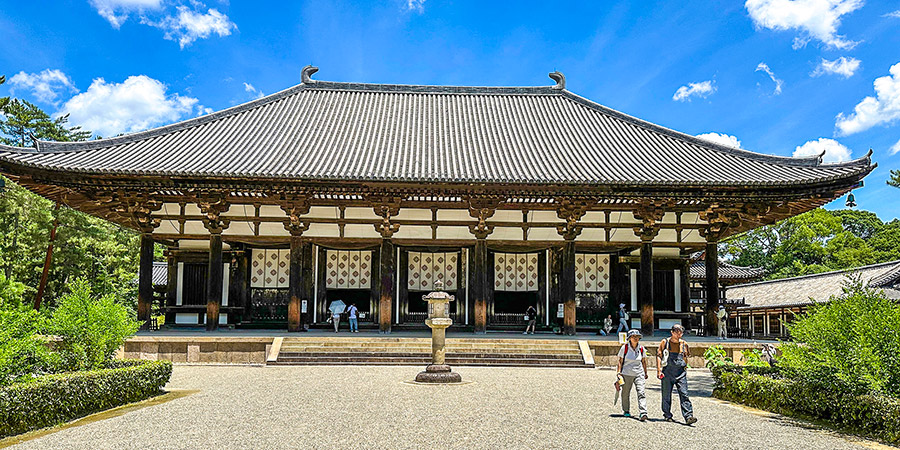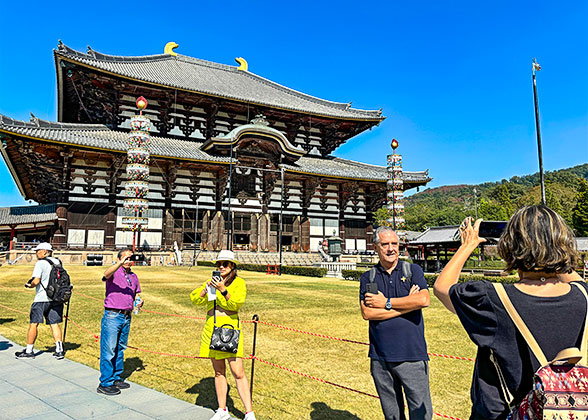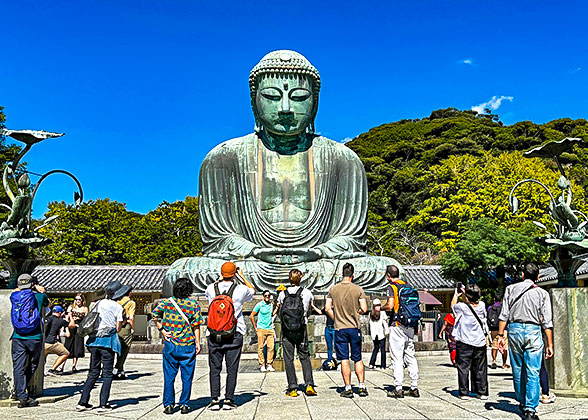Toshodaiji Temple
Toshodaiji Temple is a little far away from the center of the current Nara, but it was once located in the center of Nara during the Nara Period (710-794). The majority of buildings in the temple were established in the 8th century, and they are listed as Japanese national treasures, like the Golden Hall, the Kodo Lecture Hall, the Treasure House, and the Sutra Storehouse. Besides, it also hosts varied national treasures of Japanese Buddha statues, like Vairocana Buddha, thousand-hand Avalokitesvara Buddha, and Maitreya Tathagata statues.

Toshodaiji Temple
|
Established in 759 by Chinese Monk Jianzhen

Brief introduction on the stele
|
Monk Ganjin’s Six Attempts to Reach Japan
Ganjin is a famous Chinese monk, and he was not only proficient in Buddhism, but also an expert in architecture, painting, sculpture, and medicine. At the invitation of the then Japanese monks and emperor, Ganjin attempted to cross the sea to reach Japan to spread Buddhism five times in 12 years but failed due to various natural and political factors, and he was blinded in the process. Finally, in 756, at the age of 65, Ganjin succeeded in landing in Japan with his disciples on the sixth attempt. Given the profound influence of Ganjin, he is called one of the founders of Buddhism in Japan.What to See in Toshodaiji Temple
1. The Golden Hall
Golden Hall, also known as Kodo Hall, is the main building of the temple. The hall was established in the 8th century and mainly contains three national treasures of Japan, namely the sitting statue of Vairocana Buddha, the standing statue of Medicine Buddha, and the standing statue of thousand-hand Avalokitesvara Buddha. You can observe more than 800 small Buddha statues behind the Vairocana Buddha statue. If you have time, count them slowly to confirm it. The standing statue of the thousand-hand Avalokitesvara Buddha is on the left of the Vairocana Buddha statue. The statue has 953 hands, of which 42 are large hands and 911 are small hands.2. The Kodo Lecture Hall
The hall was moved here from the imperial palace of the Japanese emperor, Heijō Palace, and was used as dojo in the past. Now, it owns three wooden Japanese national treasures of Buddha statues, like Maitreya Tathagata statue, and two statues of Heavenly Kings.

Maitreya Tathagata statue
|
3. Treasure Storehouse and Sutra Storehouse
The two buildings were built side by side to store Buddhist objects and scriptures. Sutra Storehouse is the oldest building in the temple and the oldest azekura-zukuri in Japan.
|
|
|
4. Drum Tower
Drum Tower is a two-storied wooden building, also known as the Temple of Relics. It stores the Buddhist relics that Ganjin brought from China. Besides, it hosts the Japanese national treasure, the Golden Turtle Pagoda.5. Imperial Shadow Hall

Stone altar
|
6. New Treasures Hall
The hall was established in 1970, and it is used to store, repair, and display the treasures of the temple. You can find some broken Buddha statues here.Ticket: 200 yen, not included in the ticket of Toshodaiji Temple
Opening Time: 9:00~16:00
Opening Period: From March 1 to June 30, September 1 to November 30, and December 31 to January 3.
Top Events in the Temple
1. Special Exhibition of the Sitting Statue of Ganjin
Usually from June 5 to June 7, the temple will hold a special exhibition to display the sitting statue of the Ganjin in the Imperial Shadow Hall, starting at 9 am and ending at 4 pm. You need to pay 1,000 yen to see it. By the way, the date may be different in some years.2. Exhibition of Chinese Snowball Viburnum
Chinese Snowball Viburnum is a beautiful white flower that was brought by Ganjin from China. The Imperial Shadow Hall will conduct the exhibition of Chinese Snowball Viburnum from mid-April to early May, and it is open from 9:00 to 16:00. The exhibition dates may vary based on the actual blooming period of the flowers.3. Round Silk Fan Event
Every year on May 19 at 15:00, people will stand on the drum tower and scatter hundreds of fans. Round silk fans are said to have the benefit of warding off illness and evil spirits.Opening Time and Ticket Fare of Toshodaiji Temple
It is open from 8:30 to 17:00, and you need to enter before 16:30. The ticket is 1,000 yen, and visitors need to pay an extra fee for some halls and exhibitions inside.How to Get to Toshodaiji Temple
1. Take Kintetsu Kashihara Line, then get off at Nishinokyo Station, and walk for about 10 minutes.2. Take the JR Nara Line, then get off at JR Nara Station. Next, you can take the Nara bus at the JR Naraeki Bus Stop, then get off at the Toshodaiji Bus Stop; it takes about 20 minutes from the JR Naraeki Bus Stop to Toshodaiji Temple.
3. Take Kintetsu Nara Line, and get off at Kintetsu Nara Station. Next, you can take the Nara bus at the Kintetsu Nara Station, then get off at the Toshodaiji Bus Stop; it takes about 25 minutes from the Kintetsu Nara Station to Toshodaiji Temple.
Recommended Visit Time
About 0.5 hour.Nearby Attraction to Visit
After visiting the Toshodaiji temple, you can walk to Yakushiji Temple, which takes about 8 minutes. Yakushiji Temple is a small temple established in 680, and it worships Medicine Buddha, who can protect people from diseases.
See More:




